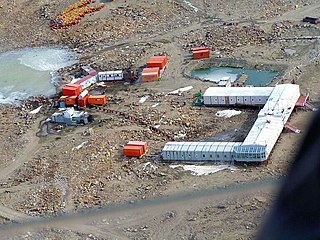
The Indian Antarctic Programme is a multi-disciplinary, multi-institutional programme under the control of the National Centre for Polar and Ocean Research, Ministry of Earth Sciences, Government of India. It was initiated in 1981 with the first Indian expedition to Antarctica. The programme gained global acceptance with India's signing of the Antarctic Treaty and subsequent construction of the Dakshin Gangotri Antarctic research base in 1983, superseded by the Maitri base from 1989. The newest base commissioned in 2012 is Bharati, constructed out of 134 shipping containers. Under the programme, atmospheric, biological, earth, chemical, and medical sciences are studied by India, which has carried out 40 scientific expeditions to the Antarctic.

The United States Antarctic Program is an organization of the United States government which has a presence in the Antarctica continent. Founded in 1959, the USAP manages all U.S. scientific research and related logistics in Antarctica as well as aboard ships in the Southern Ocean.
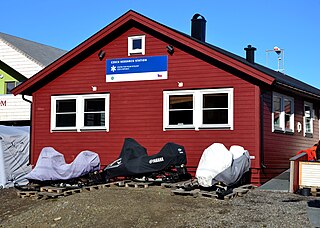
Research stations are facilities where scientific investigation, collection, analysis and experimentation occurs. A research station is a facility that is built for the purpose of conducting scientific research. There are also many types of research stations including: biological field stations, space stations etc. Research station sites might include remote areas of the world, oceans, as well as outer space, such as the International Space Station. Biological research stations developed during a time of European colonization and imperialism where naturalists were employed to conduct observations on fauna and flora. Today, the discipline is represented by a number of organizations which span across multiple continents. Some examples include: the Organization of Biological Field Stations and the Organization for Tropical Studies.

The Scientific Committee on Antarctic Research (SCAR) is an interdisciplinary body of the International Science Council (ISC). SCAR coordinates international scientific research efforts in Antarctica, including the Southern Ocean.
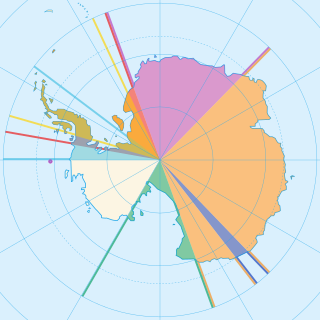
Colonization of Antarctica refers to establishment of civilian settlements in Antarctica having humans, including families, living on the continent of Antarctica. Currently, the continent hosts only two civilian settlements, the Argentinian-administered Esperanza Base and Chilean-administered Villa Las Estrellas, as well as about 70 scientific and military bases with a transient population of scientists and support staff. Antarctica is the only continent on Earth without indigenous human inhabitants, despite its proximity to Argentina and Chile at the Antarctic Peninsula.

James William Slessor Marr was a Scottish marine biologist and polar explorer. He was leader of the World War 2 British Antarctic Expedition Operation Tabarin during its first year, 1943–1945.
The Soviet Antarctic Expedition was part of the Arctic and Antarctic Research Institute of the Soviet Committee on Antarctic Research of the Academy of Sciences of the USSR.
The British Antarctic Survey (BAS) is the United Kingdom's national polar research institute. It has a dual purpose, to conduct polar science, enabling better understanding of global issues, and to provide an active presence in the Antarctic on behalf of the UK. It is part of the Natural Environment Research Council (NERC). With over 400 staff, BAS takes an active role in Antarctic affairs, operating five research stations, one ship and five aircraft in both polar regions, as well as addressing key global and regional issues. This involves joint research projects with over 40 UK universities and more than 120 national and international collaborations.

The Heroic Age of Antarctic Exploration was an era in the exploration of the continent of Antarctica which began at the end of the 19th century, and ended after the First World War; the Shackleton–Rowett Expedition of 1921–1922 is often cited by historians as the dividing line between the "Heroic" and "Mechanical" ages.
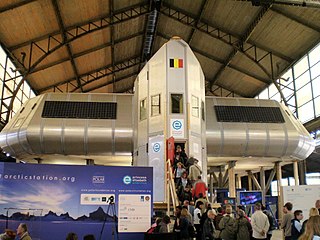
Princess Elisabeth Antarctica, located on Utsteinen Nunatak in Queen Maud Land, is a Belgian scientific polar research station, which went into service on 15 February 2009.
The Machu Picchu Scientific Base is a Peruvian polar scientific research facility in Antarctica, established to conduct Antarctic research on geology, climatology and biology. More specifically, its purpose is to study the continent's geological past, potential sea resources, wind strengths, air pollution, and the animal adaptation in a freezing environment. The base is named after the World Heritage site Machu Picchu.
The Pakistan Antarctic Programme, abbreviated as PAP) is a scientific administrative division of the Ministry of Science and Technology (MoST) which represents the Government of Pakistan on the continent of Antarctica. The program coordinates scientific research and operational support in the region. The program is funded by the Pakistan Science Foundation and the Ministry of Science and Technology.

Antarctica is Earth's southernmost and least-populated continent. Situated almost entirely south of the Antarctic Circle and surrounded by the Southern Ocean, it contains the geographic South Pole. Antarctica is the fifth-largest continent, being about 40% larger than Europe, and has an area of 14,200,000 km2 (5,500,000 sq mi). Most of Antarctica is covered by the Antarctic ice sheet, with an average thickness of 1.9 km (1.2 mi).
Ozone depletion and climate change, or Ozone hole global warming in more popular terms, are environmental challenges whose connections have been explored and which have been compared and contrasted, for example in terms of global regulation, in various studies and books.

Dhruv Raina is a philosopher and historian of science from India. He is best known for his work on the domestication of science in colonial India, transnational intellectual networks of science and historiographies of science. Currently he is Professor of History of Science Education at the Zakir Husain Centre for Educational Studies (ZHCES), Jawaharlal Nehru University, New Delhi (2003-). He had been a scientist at the National Institute of Science, Technology and Development Studies (NISTADS), New Delhi from 1991 to 2002. He was the first Heinrich Zimmer Chair for Indian Philosophy and Intellectual History, Ruprecht-Karls-Universität Heidelberg, Germany (2010–11). His basic training is in physics, and he completed his doctoral studies with Aant Elzinga in the philosophy of science from the University of Gothenburg, Sweden on the Jesuit enlightenment historiography of Indian astronomy and mathematics.

Anna Wåhlin is a Swedish researcher on the Antarctic and the polar seas. She is a professor of physical oceanography at the University of Gothenburg and co-chair of the Southern Ocean Observing System.

Cornelia Lüdecke is a German polar researcher and author. A leading figure in the history of German polar research and the history of meteorology and oceanography, she founded the Expert Group on History of Antarctic Research within the Scientific Committee on Antarctic Research (SCAR), institutionalising historical study and reflection for the Antarctic scientific community. Her books, among others, about the Schwabenland Expedition to Antarctica during the Third Reich and Deutsche in der Antarktis are milestones in the history of polar research publications.

There may have been women in Antarctica and exploring the regions around Antarctica for many centuries. The most celebrated "first" for women was in 1935 when Caroline Mikkelsen became the first woman to set foot on one of Antarctica's islands. Early male explorers, such as Richard Byrd, named areas of Antarctica after wives and female heads of state. As Antarctica moved from a place of exploration and conquest to a scientific frontier, women worked to be included in the sciences. The first countries to have female scientists working in Antarctica were the Soviet Union, South Africa and Argentina.
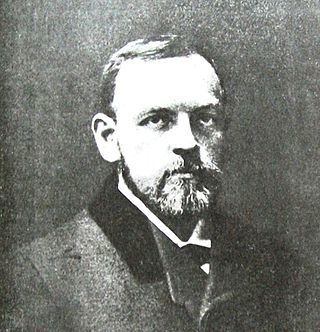
Between 1912 and 1914, plans were discussed between proponents in Sweden and Britain for a joint Anglo-Swedish Antarctic Expedition. The impetus for this enterprise came from the geologist and explorer Otto Nordenskjöld, who had led the 1901–03 Swedish Antarctic Expedition He wished to continue and extend the work begun there. The British involvement in the new venture arose because Nordenskjöld planned to finance it from the profits of a whaling company which he proposed to set up. For this, he needed to obtain a licence from the British authorities, who controlled all whaling activities in the sector of the Antarctic in which Nordenskjöld intended to operate.

The Antarctic gateway cities are five cities on the rim of the Southern Ocean through which nearly all cargo and personnel bound for Antarctica pass. From west to east, they are Punta Arenas, Chile; Ushuaia, Argentina; Cape Town, South Africa; Hobart, Australia; and Christchurch, New Zealand. As Antarctica is a low-resource environment with no major transportation infrastructure of its own, gateway cities are a necessary part of all Antarctic activities.














